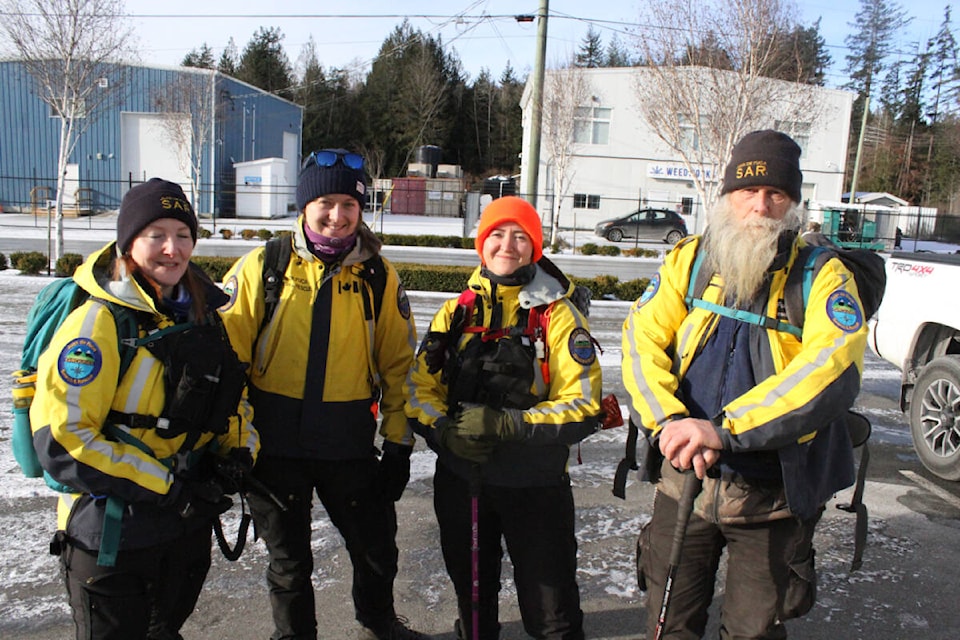Search and rescue can often be seen as a forgotten child of the emergency services family, says search and rescue manager Victoria Clark.
The Juan de Fuca Search and Rescue (SAR) team – which Clark is a manager of – will be called out at a moment’s notice when police or ambulance cannot reach or find an individual. But unlike police, ambulance or fire, there is no direct line to this search and rescue team and they will only ever be assigned to a task directly from an RCMP unit, paramedic or local police detachment.
The unit of nearly 45 members had met on a frigid Saturday morning (Jan. 13) to run a series of theory and practical training sessions, going over various search techniques and then putting them into practice.
These search-and-rescue techniques had plenty of real-world use as this team was instrumental in locating the remains of hiker Melissa McDevitt, the American tourist who had gone missing in Sooke. It was later confirmed that she had died while on a trail near the Sooke Potholes.
READ MORE: Woman missing for nearly a year in Sooke found dead
“One of the biggest tools that are available to us uses all our senses, including smell,” said Evan Nugent, one of the search and rescue operatives.
A funky smell, similar to old milk or day-old salmon, might be a key clue for a search team and allow them to locate a dead body that might not be able to be seen with the eye, Nugent said.
On the exercise, the teams had not been able to locate the training dummy and had started to make their way back to base camp, but in a real-life situation, this is the exact moment SAR teams need to determine if they have to escalate a situation, Clark said.
“We’d be thinking: Do we need dogs? Do we need helicopters? Do we need to call in more to help? So we’re looking at the map and area we have covered.”
However, the team does not have access to dogs or a helicopter of their own, so a call for assistance is the next step. Other SAR teams in the area, such as the Royal Canadian Marine Search and Rescue Team, who are responsible for search and rescue operations at sea.
The SAR team will only be activated for people who want to be found and do not pose a risk for their team, said Brian Webb, who’s charge of safety and the longest-serving member on the team.
“The Juan de Fuca trail in Sooke will account for many of the calls we get. I often joke with people that even though I have been on the JDF trail to help rescue or search for people, I spent too much time looking at the ground to tell you what the view is like.”
The term search and rescue outlines specific roles the SAR team will perform. A rescue involves knowing where an individual is and getting to them, whereas a search involves trying to locate a person. Whether they are alive or dead is a different matter entirely.
Clark said that it can be a very stressful and trying time when looking for an individual, as the team never really knows what the outcome will likely be.
Webb and Clark both said that the most important thing someone can do before hiking is to let someone know where you are going and to carry some form of mobile phone or something that can be used for communication.
“If we know where you went, the chances are we know how to find you,” Webb said, but mobile phones can have limited use and if you go into an area with no service, then having a trip plan such as the one Adventure Smart provides, can make a difference.
The Juan de Fuca Search and Rescue team is made up exclusively of volunteers. While they can get reimbursed for specific items and uniforms with some equipment provided to them, they will have to bring some of their own gear, according to team member Liz Doyle.
“You’re given a jacket, you’re given a baseball cap, you have a license plate cover. We’re in the process of actually looking at replacements for our jackets,” Doyle said.
The training to become a search and rescue operative takes place over September, October, November, December, and January and will finish with a training exercise in February where every skill taught will be tested.
When it comes to search and rescue operations, it is best to leave the job to the professional, as quite often they will have family and friends coming down to help, which is understandable, Nugent said.
“If you do come, it is best to wait to be told what to do, as you might start looking in the wrong area or end up needing to be rescued, making a difficult job that much harder.”
READ MORE: More snow, freezing rain could cause havoc on Greater Victoria streets
